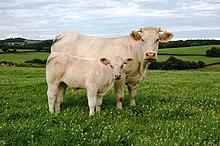Charolais cattle

Charolais cow and calf
|
|
| Country of origin | France |
|---|---|
| Distribution | World-wide |
| Use | Beef |
| Traits | |
| Coat | White |
| Horn status | Horned |
|
|
The Charolais (French pronunciation: [ʃaʁɔlɛ]) is a breed of taurine beef cattle from the Charolais area surrounding Charolles, in Burgundy, in eastern France. Charolais are raised for meat; they may be crossed with other breeds, including Angus and Hereford cattle. A cross-breed with Brahmans is called Charbray and is recognised as a breed in some countries.
The breed was introduced to the southern United States from Mexico in 1946.Then later In 1965 it was introduced in the northern New England states from Canada
The breed tends to be large-muscled, with bulls weighing up to 1,100 kg (2,400 lb) and cows up to 900 kg (2,000 lb). In England, a bull of this breed has reached a weight of 2 tonnes.
The Charolais is the second-most common cattle breed in France after the Holstein and the most common beef breed, ahead of the Limousin. France had 4.22 million head of Charolais cattle as of Dec. 31, 2014, including 1.56 million cows, declining 0.6% from a year earlier. The Charolais is a world breed: it is reported to DAD-IS by 68 countries, of which 37 report population data. The world population is estimated at about 730,000. The largest populations are reported from the Czech Republic and Mexico.
...
Wikipedia
